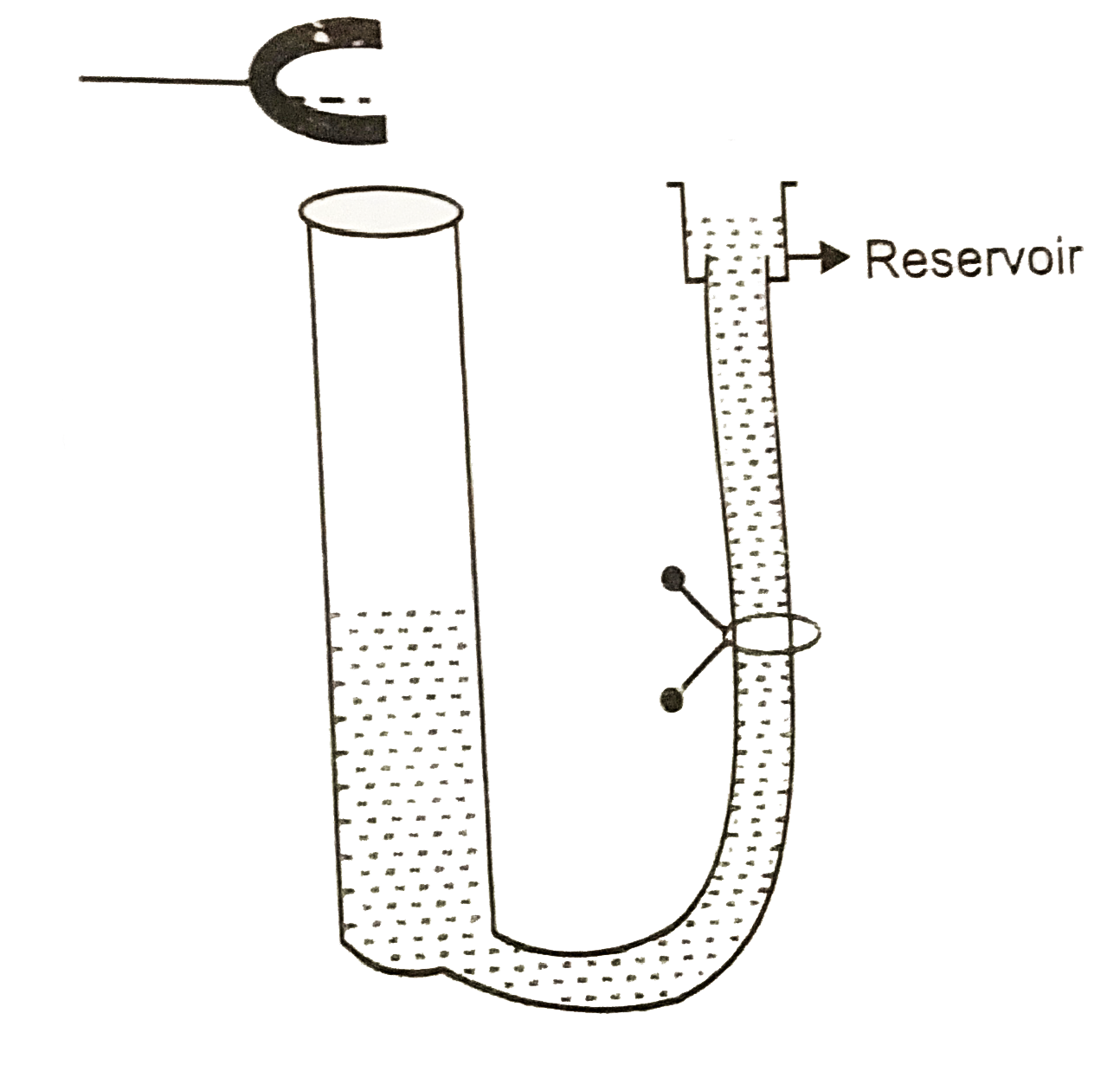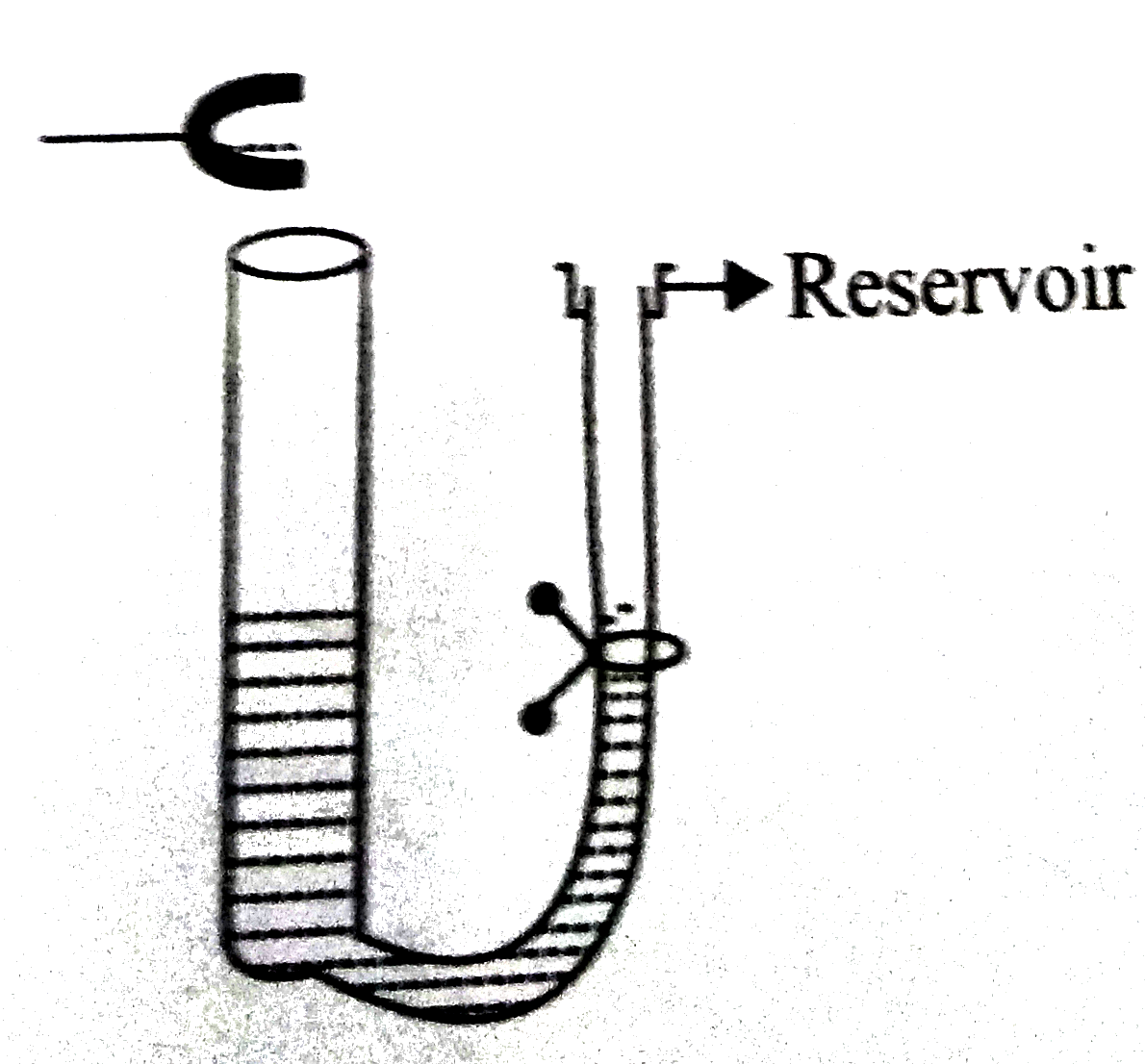A tuning fork vibrating with a frequency of 512 Hz is kept close to the open end of a tube filled with water. The water level in the tube is gradually lowered. When the water level is 17 cm below the open end, maximum Intensity of sound is heard. If the room temperature is 20∘C, calculate :
(a) speed of sound in air at room temperature
(b) speed of sound in air at 0∘C
(c) if the water in the tube is replaced with mercury, will there be any difference in your observations ?

(a) For maximum intensity of sound wave at open end of cosed pipe, we hace (in the first mode) L=λ4
∴λ=4L=4×0.17=0.68m
Now, v=fλ=(512)(0.68)=348.16m/s
(b) Speed of sound in air is v∝√T
∴v1v2=√T1T2 (Where v1= speec of sound in air at 0∘C temp.)
∴v1348.6=√0+27320+273
∴v1=348.16×√273293≈336ms
(c) (c) Mercury is 13.6 times denser than water. Hence its surface has reflectively much more than that of water. Hence, when water is replaced by mercury, we get almost total reflection of sound waves from its surface. Hence, we get greater intensity of reflected sound as compared to water surface. But certainly wavelength and speed of reflected sound wave will remain same.
Topper's Solved these Questions
- WAVESBOOK - KUMAR PRAKASHANCHAPTER - WAVESEXERCISE - SECTION-D (NCERT Exemplar Solution) (Long Answer Type Questions)
5 Videos
- WAVESBOOK - KUMAR PRAKASHANCHAPTER - WAVESEXERCISE - SECTION-E (Multiple Choice Questions (MCQs)) (MCQs asked in Gujarat Board and Competitive Exams)
54 Videos
- WAVESBOOK - KUMAR PRAKASHANCHAPTER - WAVESEXERCISE - SECTION-D (NCERT Exemplar Solution) (Very Short Answer Type Questions)
7 Videos
- UNITS AND MEASUREMENTBOOK - KUMAR PRAKASHANCHAPTER - UNITS AND MEASUREMENTEXERCISE - Section -F (Questions from Module )
20 Videos
- WORK, ENERGY AND POWER BOOK - KUMAR PRAKASHANCHAPTER - WORK, ENERGY AND POWER EXERCISE - QUESTION PAPER (SECTION - D)
1 Videos
Similar Questions
A tuning fork vibrating with a frequency of 512 Hz is kept close to the open end of a tube filled with water , figure. The water level in the tube is gradually lowerd. When the water level is 17cm below the open end, maximum intensity of sound in heard. If the room temperature is 20∘C, calculate
(a) speed of sound in air at room temperature.
(b) speed of sound in air at 0∘C
(c) if the water in the tube is replaced with mercury, will there be any difference in your observations?

View SolutionA tuning fork vibrating with a frequency of 512 Hz is kept close to the open end of a tube filled with water , figure. The water level in the tube is gradually lowerd. When the water level is 17cm below the open end, maximum intensity of sound in heard. If the room temperature is 20∘C, calculate
(a) speed of sound in air at room temperature.
(b) speed of sound in air at 0∘C
(c) if the water in the tube is replaced with mercury, will there be any difference in your observations?

View Solution
Knowledge Check
A tuning fork vibrating with a frequency of 500 Hz is kept close to the open end of a tube filled with water, as shown in figure. The water level in the tube is gradually lowered When the water level is 17 cm below the open to open end, maximum intensity of sound is heard. If the room temperature is 20∘ C, the speed of sound in air at the temperature is
 A1. 330ms−1B2. 340ms−1C3. 350ms−1D4. 360ms−1
A1. 330ms−1B2. 340ms−1C3. 350ms−1D4. 360ms−1A tuning fork vibrating with a frequency of 500 Hz is kept close to the open end of a tube filled with water, as shown in figure. The water level in the tube is gradually lowered When the water level is 17 cm below the open the open end, maximum intensity of sound is heard. If the room temperature is 20∘ C, the speed of sound in air at the temperature is
 A330ms−1B340ms−1C350ms−1D360ms−1
A330ms−1B340ms−1C350ms−1D360ms−1A vibrating tuning fork is held over a water column with one end closed and the other open. As the water level is allowed to fall, a loud sound is heard for water levels separated by 17 cm. If the speed of sound in air is 340 m/s, the frequency of the tuning fork is:
A500 HzB1000 HzC2000 HzD5780 Hz
A tuning fork of frequency 250 Hz is vibrating at one end of a tube as shown in the figure. If maximum sound is heard at the other end, then the velocity of the waves will be

View SolutionAn excited tuning fork of frequency 512 Hz is held over the open end of a tall jar and water is slowly poured into it. Resonance was first observed at a level and then at a higher level. Calculate the difference in heights of the two levels. Velocity of sound in air at the time of experiment is 346 m/s.
View SolutionIn a long cylindrical tube , the water level is adjusted and the air column above it is made to vibrate in unison with a vibrating tuning fork kept at the open end . Maximum sound is heard when the air column lengths are equal to
View SolutionVibrating tuning fork of frequency v is placed near the open end of a long cylindrical tube. The tube has a side opening and is fitted with a movable reflecting piston. As the piston is moved through 8.75 cm, the intensity of sound changes from a maximum to minimum, if the speed of sound is 350 m/s. Then v is

View SolutionA tuning fork of frequency 340 Hz is vibrated just above the tube of 120 cm height. Water is poured slowly in the tube. What is the minimum height of water necessary for the resonance? (speed of sound in the air = 340m/s)
View Solution
